Social and economic development. Рубрика в журнале - Arctic and North
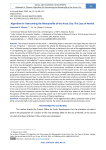
Algorithm for Overcoming the Monoprofile of the Arctic City: The Case of Norilsk
Статья научная
The research question of the article — identifying ways to overcome the single-industry nature of the city of Norilsk — have been concretized by solving the following tasks: to substantiate the “specificness” of Norilsk among the largest Arctic cities of Russia; to determine the role of the agglomeration effect in strengthening the support of Norilsk for the projects of Taimyr and the entire Eastern Arctic; to determine the potential of Norilsk Nickel’s service structures and urban entrepreneurship for new mining and infrastructure projects in the Eastern Arctic; propose mechanisms for implementing the Norilsk Support Strategy. The methodological base of the study was formed by the concepts of technological modes, development blocking of old-industrial / mono-industrial territories and supportive settlements. Main results: Norilsk is the most specific among the largest Arctic cities of Russia according to the composite index, made up of nine key demographic, economic, socio-cultural indicators. Non-standard approaches are needed to diversify its economy. The agglomeration effect can constructively contribute to Norilsk’s transformation from a single-industry city into a base city for the development of the Eastern Arctic. The most important areas of structural transformation of Norilsk’s economy include strengthening the practice-orientation and geographical expansion of consumers of services of the local scientific and educational complex; establishment of an entrepreneurial layer in new industries and types of production activities; and entry of the city's entrepreneurship together with the plant's service structures into the market of projects and settlements in the Eastern Arctic. The main mechanisms for the implementation of the Norilsk Strategy are: “mirror” actions in the eastern Arctic of the city and the Norilsk Nickel combine; transformation of Norilsk into a center for the provision of security services for the territories of the eastern Arctic; a center of formation of the Arctic cruise tourism from Dudinka to Anadyr; a center for accumulating best practices of renovation of the Arctic housing and communal services for their replication in the cities and towns of the Eastern Arctic. Recognition of Norilsk’s success in becoming a base city in the Eastern Arctic will be an increase in its administrative status: transformation into a city of federal significance.
Бесплатно
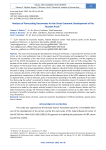
Analysis of Forecasting Documents for the Socio-Economic Development of the Russian Arctic
Статья научная
The tasks of forecasting the development of Russian territories, in particular the territory of the Arctic, are the most problematic due to the urgent need of the economy and management for a reliable forecast, the uncertainty of the near future caused by the turbulence of geopolitics, and the ongoing impact of the COVID-19 pandemic on socio-economic processes, which are also not fully measurable. The purpose of the article is to present the initial grounds and forecast of the socio-economic development of the regions of the Russian Arctic with a lead time up to 2023. The methodological peculiarity of the research is to take into account geopolitical, national, regional, industrial factors and development trends on the basis of using: 1) the analysis results of real and perspective global trends recorded in statistical indicators, forecast documents of the IMF, WTO, Central Bank, Ministry of Economic Development of Russia; 2) generalizations, comparisons of official forecasts and development plans of the AZRF adopted at the federal, regional levels, as well as forecasts, plans of corporations operating in the AZRF; 3) analysis of real statistical data using the author's econometric models. Given the considerable amount of analytical information received, the aspects and factors that have a key influence on the prospects of socio-economic development of the Arctic are outlined and classified according to the following levels: global, national, regional. Forecasts are made for the regions entirely located in the Arctic zone — Yamalo-Nenets, Nenets and Chukotka Autonomous okrugs, the Murmansk Oblast with an anticipation period up to 2021-2023. The importance of scientific forecasting in modern conditions is emphasized, encouraging reflection, new hypotheses, discussions.
Бесплатно
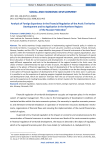
Статья научная
The article examines foreign experience in implementing regional financial policy in relation to the Arctic territories. It assesses the experience of such sub-arctic countries as Canada, Finland, Denmark, Norway, Sweden, and the USA. The paper identifies two groups of financial instruments of territorial development: within the framework of general regional policy (instruments of fiscal capacity equalization, taxation instruments, instruments to increase investment attractiveness) and within the framework of special policy for the development of Arctic territories (program-targeted instruments, special development funds, direct allocation of funds for current expenses and development). It is concluded that the Arctic countries apply different approaches and tools to the development of the regions located in the Arctic zone, the choice of which is determined by the type of state structure, the degree of financial independence of the regions in the sphere of financial regulation, the level of development of the northernmost subjects compared to the rest of the country. In the conditions of Russia, it is possible to use the best foreign experience in the sphere of financial regulation of development of the regions located in the Arctic zone. In particular, it is possible to use the experience of applying program-targeted development tools, the formation of special development funds, which are based on revenues from the use of natural resources of the Arctic, as well as the experience of creating favourable conditions to attract investors for the implementation of economically attractive projects.
Бесплатно
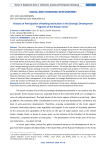
Статья научная
The article examines the issues of financing the development of the Russian Arctic territories and the participation of banking structures in this process. A set of strategic documents for the development of the Arctic zone of the Russian Federation is considered, the dynamics of approved amounts of funding for Arctic development programs are analyzed, and the structure of sources of financing for investment in fixed assets in regions whose territory belongs to the Arctic zone of the Russian Federation is studied. It is concluded that banks are not sufficiently involved in investment activities in most of the Arctic regions (except the Yamal-Nenets Autonomous district, where the active role of banking institutions is due to participation in the financing of large gas and oil production projects in the Northern part of the region), and in recent years, foreign banking structures decline investment activity. The article describes the prospects of participation of the largest Russian banking structures in implementing large-scale projects in the Arctic, such as VTB Bank, Sberbank of Russia, and Gazprombank. The analysis of the possibilities of concentration of banking capital, as well as the use of mechanisms of public-private partnership based on the creation of a single financial institution with state participation is performed. The most effective form of improving the efficiency of financial flows management in the framework of strategic development of the Arctic territories can be the creation of The Bank for reconstruction and development of the Arctic.
Бесплатно
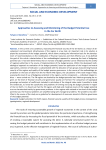
Approaches to Assessing and Monitoring of the Budget Potential Use in the Far North
Статья научная
In the current crisis conditions, improving the financial security of the territories as a factor of development and investment attractiveness of the regions is a key task. An important role in its solution is played by assessment of the budget potential, which allows creating the information basis for the development of recommendations on the mobilization of financial resources and their effective use. It has defined the goal of this article: substantiation of the methodological approach to assessing the level of budgetary potential use. It has been determined, that an increase of budget potential can be influenced by the activity of regional authorities in the course of implementation of the budget process. Within the developed methodological approach to evaluation of the budget potential, based on application of the integral and matrix approaches, selection of indicators is substantiated with the allocation of two groups characterizing financial security of the regions and quality of the budget process governance. In the course of the methodology approbation on the basis of data from the Far North (FN) regions, the calculations of the total integral index, assessing the level of use of budgetary potential in the regions, and its components — individual integral indices — were carried out. The FN regions are leveled by the budget potential use. Matrices grouping the regions on the level of financial security and governance quality are formed. The comparison of typological groupings and analysis of coefficients included in calculation of the integral index made it possible to study the tendencies, to reveal the specificities and problems of forming and using the budget potential in region of the Far North. It is found out that the FN regions with high and moderate levels of the budget potential use are characterized mainly by governance problems. In the regions with reduced or low level of the budget potential use, the financial problems are amplified along with managerial problems. The problem areas identified in the course of the study are a guideline for development of measures aimed at effective governance of the budget potential.
Бесплатно
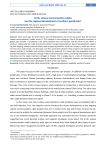
Arctic subsea communication cables and the regional development of northern peripheries
Статья научная
Some years ago, the Arctic Ocean was still described as one of the last oceans that did not have subsea communications cables across it. This situation is now changing. One of the greatest increases in global data transfer is predicted to be traffic between Asia and Europe, and the Arctic Ocean offers a shortcut, making physical cable connections shorter and decreasing latency. Recent developments regarding two ongoing subsea communications cable projects (Quintillion and Arctic Connect), which aim to connect East Asia and Europe, are discussed, and the connection between these projects and regional development policies in Hokkaido and northern Finland are analysed. It is shown that the proposition that improved international connectivity through subsea communications cables could bring information-intensive industries into the region had been stronger in Finland. This is largely due to a lack of information and awareness concerning these projects among the regional actors in Hokkaido; however, no concrete policy or funding instrument has been developed in either of the case regions.
Бесплатно
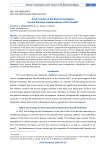
Arctic tourism in the Barents Sea region: current situation and boundaries of the possible
Статья научная
The modern features and peculiarities of the organization of the Arctic tourism in the Russian Federation are considered. Over the past ten years, the geography of recreational nature management and international tourism in the Russian Arctic has significantly expanded. Among the northern countries, Russia has the longest coastline in the Arctic seas and the largest sector of the adjacent shelf and waters of the seas of the Arctic Ocean. So its economic and political interests in the polar zone are obvious. However, compared with neighboring Arctic countries, in the Russian Federation for several reasons the potential of Arctic tourism is far from being fully utilized, and its further development is regulated by natural and anthropogenic factors. On the example of the actively developing Arctic cruise tourism in the Barents Sea region, the existing problems and prospects of the possible development of tourism in the Arctic in modern conditions are discussed. Based on the studies characterizing the modern development of Arctic tourism in general and in the Barents Sea basin in particular, the author made generalizing conclusions, which list the factors limiting the development of Arctic tourism in the Russian Federation.
Бесплатно
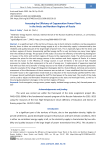
Assessing the Efficiency of Cogeneration Power Plants in the Arctic and Northern Regions of Russia
Статья научная
In a significant part of the territory of Russia, due to harsh climatic conditions and low population density, there is either no centralized energy supply at all, or the electricity supply is characterized by low reliability and quality because of the large length of power lines. This is especially typical for the Arctic and northern regions of Russia. Economically justified energy tariffs in such territories are many times higher than the statistical average. The purpose of this study is to assess the efficiency of transferring heating boiler houses in the Arctic and northern regions of Russia to the cogeneration mode. The article presents and analyses the prices for the main energy sources in the northern and Arctic regions of Russia. It is shown that the key factor in the efficiency of energy sources in such territories is the cost of fuel. Possible measures to reduce the fuel component in the cost of energy are: 1) replacement of expensive imported fuel with local fuel and 2) transfer of energy sources to the mode of combined heat and power generation. Using the example of the village of Erbogachen (Katangskiy district, Irkutsk Oblast), technical and economic assessment of the effectiveness of these measures was carried out. It was established that the transfer of the boiler house to the cogeneration mode leads to a reduction of the economically justified tariff for electric power almost twofold while keeping the tariff for heat power at the same level. The results of the study can be used to adjust and formulate investment programs at the state and municipal levels, as well as in the energy development strategies in the northern regions of Russia.
Бесплатно
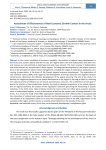
Assessment of Effectiveness of New Economic Growth Centers in the Arctic
Статья научная
In the current conditions of economic instability, the problem of regional space development in the Arctic zone, Eastern Siberia and the Far East, the regions where the main hydrocarbon and other mineral reserves are concentrated, is becoming more and more relevant. The main reserves of hydrocarbons and other minerals are concentrated in these regions. The integrated development of the mineral resource base on the principles of rational nature management, including the stages of exploration, production, processing, transportation, is the driver of the Russian regional economy development. The organization of raw materials centers (RMC) with regard to the development of energy resources and regional transport infrastructure, determines the effective development of the spatial economy. The aim of the study is to develop an integrated approach to the spatial development of the region by forming an RMC for achieving the national priority of efficient use of natural and economic resources. The achievement of the goal requires the solution of interrelated tasks, namely, the study of domestic experience in the spatial organization of regional economy; the analysis of the regulatory framework governing the functioning of specific industries in the Arctic zone, Eastern Siberia and the Far East in order to further socio-economic development of undeveloped regions, as well as the analysis of data on the current state of energy reserves in the Arctic. As a result, the study of the RMC organization indicates that their effectiveness is associated with the interaction of national and corporate interests and the development of a communication system. The interrelation of all components allows us to assess the multiplicative effect of the RMC organization on the economy of the region and the country as a whole, which determines the novelty of the work.
Бесплатно
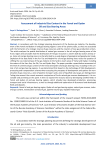
Assessment of Industrial Gas Content in the Yamal and Gydan Oil and Gas Bearing Areas
Статья научная
In accordance with the strategic planning documents of the Russian gas industry, the development of the Yamal and Gydan oil and gas bearing regions is one of the priority tasks, as they are associated with the formation of a strategic reserve of gas resources and the creation of new gas production centers. The article analyses the spatial distribution of natural gas reserves in the oil and gas bearing areas of the Arctic region and concludes that the distribution of free gas resources is uneven both by section and by area. Some oil and gas bearing areas are characterized by a weak degree of geological and geophysical study. Depletion of the base fields in the Pur-Taz and Nadym-Pur oil and gas bearing areas raises the question of shifting the raw material base of the gas industry to the hard-to-reach areas of Yamal and Gydan, including the waters of the Kara Sea, the Ob, Taz and Gydan Bays. The paper provides a quantitative assessment of the level of commercial gas content of the Yamal and Gydan oil and gas bearing areas, including in the context of oil and gas bearing regions. It was determined that based on the technology of field development, processing and transportation scheme when assessing the prospects of development and options for monetization of gas resources, a zone of pipeline transport and a zone of liquefied natural gas are distinguished. Taking into account the current economic conjuncture of Arctic natural gas reserves development, it is reasonable and promising at this point in time to expand the resource base by developing satellite fields in Yamal and Gydan oil and gas bearing regions, which already have developed production, processing, transport and social infrastructure, as well as through additional exploration of discovered and developed fields and deposits.
Бесплатно
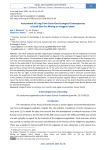
Assessment of Long-Term Socio-Geo-Ecological Consequences of Lead-Zinc Ore Mining on Vaygach Island
Статья научная
The article evaluates possible negative geo-ecological consequences for the inhabitants of Varnek settlement from the development of polymetallic ore deposit in the southwest of Vaygach Island in the first half of the 20th century. Accumulation of heavy metals in algae of lagoonal estuaries of the Krasnaya (control site) and Varkutsyakha (background site) rivers was considered. There is an abandoned lead-zinc ore mine on the watershed of the Krasnaya River, where dumps of lead-zinc ore were left. The data were obtained that in the mouth of this river there is a significant accumulation of heavy metals in filamentous algae and fucus compared to the background site. At the same time, the content of lead in algae of the control site exceeding the permissible sanitary norm by 4.8 times was recorded. It is assumed that when waterfowl and fish use algae as food (through zooplankton and zoobenthos), lead in excessive concentrations may enter the organisms of local Nenets, for whom fishing and hunting have become the main occupation in the conditions of observed unemployment. To prevent possible negative effects of polymetallic ore mining on the human body, recommendations are given on what areas on the island should be avoided when setting up stations and bases for activities within the framework of the Vaygach State Nature Reserve and for tourism development.
Бесплатно
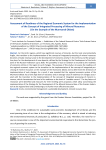
Статья научная
For the Arctic regions, which have significant reserves of minerals, but the most environmentally fragile, the transition to the implementation of the concept of integrated processing of mineral resources becomes critically necessary due to the development of economic activity in this territory and the prospective plans for the development of new deposits, defined by the Strategy for the Development of the Arctic Zone of the Russian Federation up to 2035. The possibility of such a transition is ensured by the readiness of economic entities in the region to such changes. The purpose of this study is to assess the readiness of the regional economic system to the transition to the implementation of the concept of integrated processing of mineral resources on the example of the Murmansk Oblast and to determine the directions of implementation of such changes. As a result, it was revealed that the regional economic system of the Murmansk Oblast has a fairly high level of resistance and an average value of readiness for changes associated with the transition to the implementation of the concept of integrated processing of mineral resources, which characterizes the level of its readiness as the level of "unstable success". The key factors of resistance were identified and measures for their levelling were proposed, which allow concretizing the implementation of the Strategy for the Development of the Mineral Resource Base of the Russian Federation at the regional level and contributing to its further more effective execution.
Бесплатно
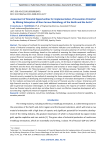
Статья научная
The analysis of methods for assessing the financial opportunities for increasing the economic efficiency of industrial enterprises using absolute and relative indicators and coefficients was carried out. A mechanism for determining financial possibilities for realizing innovative potential of northern mining enterprises of non-ferrous metallurgy, based on the method of assessing the three-component coefficient, which allows choosing the most rational strategy of scientific and technological development, taking into account financial resources and features of production functioning in the northern regions of the Russian Federation, was developed. It is shown that the proposed methodology can be used with limited information in the accounting statements provided in public access. On the basis of objective indicators, the research of innovation activity of twenty industrial enterprises of non-ferrous metallurgy directly operating in the North and the Arctic and included as subsidiaries and branches of seven largest corporations — PJSC MMC “Norilsk Nickel”, JSC “Mine Karalveem”, PJSC “Acron”, JSC “Mining company “Berelekh”, PJSC “Seligdar”, OJSC “Susumanzoloto”, JSC “Polymetal” for the period 2013–2019 was carried out. Studies showed the dependence of the innovation activity of northern enterprises of non-ferrous metallurgy on the level of financial security revealed by the method of assessing the three-component coefficient. Scientifically substantiated possibility of developing and implementing a strategy of innovation development of enterprises for the medium and long term periods based on the level of financial security is shown. Enterprises with high financial security or in special cases (with additional investments with normal financial security) are able to generate innovation technologies. As the analysis has shown, the majority of northern enterprises have low financial security, which does not allow them to count on effective innovative development without attracting a significant amount of targeted investments.
Бесплатно
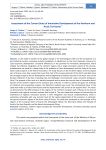
Assessment of the Current State of Innovative Development of the Northern and Arctic Territories
Статья научная
In the modern realities of the global change in the technological order and the emergence of a post-industrial society, innovative activity strengthens its significance as the most important resource for socio-economic development. Territorial differences in the potential for innovative development, which impede the effective integration of the northern regions into a single innovation system of the country, predetermine the need for a deep study of the problems of their development and the study of the main factors and prospects in the field of innovation. The study focuses on the northern regions of the European part of Russia, since they concentrate more than half of the human potential of the North and determine the strategic prospects for the development and strengthening of national security in the Arctic zone of the Russian Federation in the face of existing risks and challenges: environmental, social, economic and geopolitical. The purpose of this work is to identify prospects and to assess the current state of innovative development of the northern regions of the European part of Russia. In order to achieve the goal, the methods of statistical and comparative analysis, the dialectical method were used. The informational basis of the study was made up of data from Rosstat and the departmental civil service at the regional level. The analysis demonstrates the differentiation of the regions of the northern European part of Russia at the level of innovation and regional economic systems that include it. The most important prospect of overcoming the weaknesses of regional innovation systems is their integration and mutual complementarity, which is sometimes achievable with new systemic tools for the spatial organization of the economy, in particular, the special economic regime of the Arctic zone of Russia. The study was conducted on the example of five regions of the European North of Russia: the Arkhangelsk Oblast, the Murmansk Oblast, the Republic of Karelia, the Komi Republic and the Nenets Autonomous Okrug.
Бесплатно
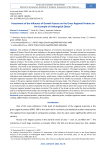
Статья научная
The problem of differentiating indicators of economic development is relevant not only for the regions of Russia. One of the main indicators is the gross regional product. The work carried out a comparative analysis of its values for the constituent entities of the Russian Federation, the United States and China, which revealed differences by tens, and sometimes hundreds of times. In most cases, this is due to the specifics of a particular region. The aim of the work is to assess the influence of regional factors on the gross regional product. The article presents an analysis of existing methods for solving this problem by modern domestic and foreign researchers. A brief overview of the key factors used in the proposed models is given. However, the trends in the development of the world and domestic economies, political events, restrictions imposed by the pandemic, regional peculiarities leave this issue relevant. The paper proposes a model for assessing the impact of objective and subjective factors on the gross regional product. The testing subject was the Arkhangelsk Oblast, located in the north of the European part of the Russian Federation. Seven indicators were selected as objective factors, which have a close correlation with the resulting indicator. A multiple regression equation was developed and the quality of the model was assessed. A forecast of the values of the gross regional product for the planning period was made. The influence of subjective factors was studied using the method of expert assessments through the analysis of ratings of influential agencies. A correction factor has been introduced into the model, with the help of which the values of the volume of the gross regional product have been corrected. The results of the study can be useful for state authorities and local self-government bodies that manage the regional development of territories, and can be used to develop a strategy for the development of the constituent entities of the Russian Federation.
Бесплатно
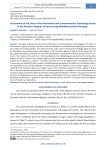
Статья научная
The paper analyzes the state of the information and communication technologies (ICT) sector in the northern regions of Russia. The main research methods are multidimensional grouping and comparative analysis of ICT development. The relevance of the study is due to the lack of knowledge about the state of information and communication technologies in the northern regions of Russia. At the same time, ICT has a great potential to stimulate the economic development of the North of Russia and the Arctic in particular. The novelty of the work lies in the development of a methodological approach to the comparative analysis of the ICT sector in the Russian regions, aimed at identifying problem areas of development. An original set of indicators is created — criteria for the state of ICT at the regional level. The validity of this set is proved by the method of factor analysis. Multidimensional grouping of all subjects of the Russian Federation according to the selected indicators is performed with an emphasis on the northern regions. It is revealed that the northern regions have higher values of ICT indicators compared to other regions of Russia due to the social sphere and the state of ICT at the household level. The leaders are the Yamalo-Nenets Autonomous Okrug, the Khanty-Mansi Autonomous Okrug and the Republic of Karelia. Practical recommendations for ICT development in the northern regions are formulated. The main reserves of ICT development in the North are identified — growth of state and municipal services provision in electronic form and digitalization of health care institutions.
Бесплатно
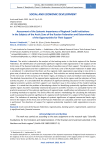
Статья научная
The article is devoted to the analysis of the banking sector in the Arctic regions of the Russian Federation, the identification of systemically significant regional credit organizations in the subjects of the Arctic zone of the Russian Federation and the study of possible areas of their support. The dynamics of existing credit organizations and their subdivisions in the Arctic zone of the Russian Federation in 2020-2021 is considered. It is determined that there are five regional credit organizations operating in nine Arctic regions now, of which one is a private non-banking one. Their activities are mainly aimed at the development of the real sector of the economy of the home region, at lending to small and medium-sized businesses. The detailed characteristics of the regional banks registered in the Arctic regions and the indicators of their activity are given. It is concluded that the allocation of significant banking structures for the functioning of regional economic systems and their support is an important issue in the analysis of the modern banking system. It is noted that the problem of developing criteria for identifying systemically significant banks for specific regions has been repeatedly raised and discussed in scientific research. It is concluded that for the practical assessment of the systemic significance of regional banks, modification and refinement of currently existing methods are required. The article offers the author's methodology for calculating the indicators used in assessing the systemic significance of a regional credit institution for a subject of the Russian Federation. The indicators of assessing the degree of systemic significance of regional commercial banks registered in the regions of the Arctic zone of the Russian Federation are calculated, and their score assessment is performed. The directions of support for regional systemically important credit organizations are presented.
Бесплатно
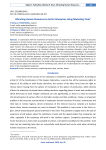
Attracting human resources to arctic enterprises using marketing tools
Статья научная
In connection with the movement of various types of production in the Arctic region, it becomes necessary to attract human resources to new enterprises. In the article, we analyze the branding system in companies operating in the Arctic region, as one of the most effective areas in marketing activities in the labor market. The study aims at investigating marketing tools that can eliminate the lack of qualified personnel in well-known companies, e.g., Rosatom, Rosneft, PhosAgro, Eurochem, Novatek, Lukoil, Severstal, Gazprom Neft, and Norilsk Nickel. Particular attention is paid to analyzing the branding of organizations, i.e., the main tool for attracting human capital to enterprises. The components of branding are considered, i.e., the brand itself, mission, purpose, and image. A table was compiled illustrating the listed elements for each company. It takes a detailed look at which companies should try to change branding elements to attract more attention from job seekers. The study of the key concepts of branding helped to draw appropriate conclusions about the need to reform marketing tools, which are not developed to one degree or another in the investigated companies.
Бесплатно
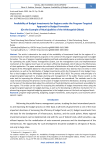
Статья научная
The article is devoted to the study of the availability of investment funds for the regions of investment funds of state development programs in the context of the program-targeted approach to budget formation. The use of program-targeted budgeting methods undoubtedly opens up extensive opportunities for optimizing the public finance management system, but the management tools and implementation mechanism at the regional level have not yet been sufficiently developed, which reduces the effectiveness of their application. The paper evaluates the uniformity of distribution of funds of the Targeted Investment Program of the Arkhangelsk Oblast for the period 2017–2021 between four districts that are similar in their parameters, as well as the distribution of budget investments within the framework of inter-budget transfers to local budgets of the Arkhangelsk Oblast for the period 2021–2023. The process and principles of a program-targeted approach to strategic planning and management of the public finance system as the main tool for improving the efficiency of budget expenditures are considered. The methods used in the study include analyzing the dynamics and structure of budget investment distribution, drawing conclusions on the basis of the obtained data about the uniformity of funds distribution and investment accessibility for the regions. This article can be useful for assessing the availability of budget investments when using the program-targeted approach to budget planning, as well as for developing an effective mechanism for implementing program-targeted budgeting approaches in the budget process at the local and regional levels.
Бесплатно
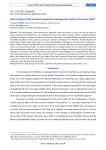
Best Practices of Oil and Gas Companies to Develop Gas Fields on the Arctic Shelf
Статья научная
The development of the hydrocarbon potential of the Arctic shelf is one of the priority tasks for Russia, forming the conditions for its strategic presence in the region. Russia's official energy documents stipulate the need to increase oil and gas production in the Arctic, including offshore production, to ensure the stable operation of the country's oil and gas complex in the long term. However, the development of hydrocarbon fields on the Arctic shelf is a serious technological challenge for the domestic oil and gas industry. While offshore oil production in the Russian Arctic is already underway, natural gas production remains a promising future target. The article analyses the current gas projects on the Arctic shelf in terms of their technological complexity and unique solutions, and the strategies of operators to attract foreign participants to the project. We consider these in the contexts of technological issues, organizational features, securing foreign investment. The author believes that the provisions and conclusions of this study will help add to the comprehensive picture of the foreign oil and gas companies experience engaged in natural gas production on the Arctic shelf, which will minimise the errors and risks in the development of hydrocarbon resources on the Russian Arctic seas shelf.
Бесплатно

